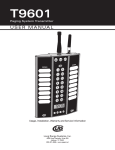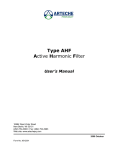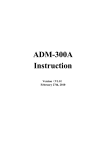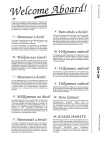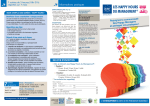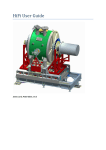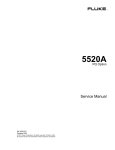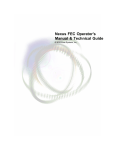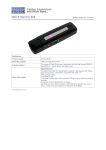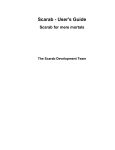Download FM ILT - PACS at Leuven
Transcript
PACS FM ILT Daily morning briefing Date: 13 November 2006, 8:30 (Monday) Running Number: 009 Participants: ICC@MPE, GJ, AlPog, B. Alt., RV, MS, KO, O. Boulade, N. Billot Absent: OHB (part time) Minutes : ES Status: - Grating was tested with 5 and 6 deg/s, data to be analysed before we try 8 deg/s. Analysis script was updated to avoid Jython loops. Diagnostic HK was analysed and made available to Benoit. Until we get confirmation that we can move faster we will use 4 deg/s (and 1deg/s for homing). - CSs: all data taken, MPIA to analyse. TM wants to extend the thermal behaviour tests a bit, to assure that the full ballistic heating phase is covered. - Chopper: MPIA left two parameter sets (for phi <= +-4.1 deg and phi = 8.1 deg) and the angular calibration report (including the maximum allowed positions). These parameter sets are not yet optimal (long transition times, asymmetries, two sets for different ranges…) but show no over/undershooting and swing in anymore and have low noise. The settings should be good enough for the bolometer tests that are planned for this week (see below). HF suggests (and will send an email to MPIA for discussion) a suite of over night tests, trying out ten thousands of controller parameter sets for further optimisation. A. Mazy will look into options to modify the s/w to account for the asymmetries and to allow different chopper parameter sets in the commanding. There will be a telecon later this week. - Limit switch investigation: this seems to be a hardware failure indeed, i.e. either the line to the switch or the switch itself is broken (the redundant switch seems to be ok). For the further tests until Christmas we will just ignore this switch. Cryostat: started pumping on Saturday, very cold now, need to adjust to 1.6K. Liquid Nitrogen has to be refilled, will be finished by ~10:30 today. First cooler recycling is planned for tomorrow. PCSS: This week MW will work on detector selection table issues. Other: Over the weekend there was a telemetry loss event, PACS was sent into save mode by the event monitor. HF and ErW to analyse. Today: FOV scans move the chopper in small steps, thermal behaviour tests use only 5Hz chopping, so the current chopper settings should be ok for this week. If confirmed we will do over night tests to further optimise the chopper settings. In order to concentrate fully on the bolometer tests where we need the French connection (which can only stay until Wednesday) we will shift the thermal behaviour test to later this week. - analyse the telemetry loss event (HF, ErW) - adjust cryostat and refill nitrogen (GJ) - get input from L. Barl for HeII Ge:Ga settings - do the SFT HeII +- 4.1 deg chopping, x-axis is in ms. + 4.1 deg chopping (zoom), x-axis is in ms. - 4.1 deg chopping (zoom), x-axis is in ms. +- 8.1 deg chopping, x-axis is in ms. + 8.1 deg chopping (zoom), x-axis is in ms. - 8.1 deg chopping (zoom), x-axis is in ms. PACS FM ILT Daily morning briefing Date: 14 November 2006, 9:15 (Tuesday) Running Number: 010 Participants: ICC@MPE, GJ, AlPog, B. Alt., RV, MS, KO, O. Boulade, N. Billot Absent: HF Minutes : ES Status: - SFT HeII was executed successfully. Analysts have been informed and are working on the data analysis. During the sorption cooler functional check-ou the stabilisation time of the cold electronics at 2K takes longer than at 4K: When using the same biases at 2K and 4K, there is not enough current in the electronics. - Towards the end some science data were lost. Possible reason: an interference with the data base replication (TBC). For the time being data base replication will only be done during spare times of the ILT (when no commands are running). Compression was not as efficient as required. - The TM problem over the weekend was a disk overflow problem. We need to assign people to check these kind of statuses and run the FM-ILT routine checks as explained on the wiki pages. RV and B. Alt. might be willing to take over this task for a while. - We then moved on to the cooler recycling test (which was originally planned for today). The pre-conditions were ok, except for the evaporator temperature, which was at 2.08K rather than the required <2K, but this has always been the case in the past. Duration: 2.2hrs (2hrs 12min). The evaporator temperature did not drop fast enough and at the end was just above the required <400mK, which then triggered a save mode. The cooler recycling has to be modified (extend the time at the end by 15 minutes or so), and we need to pump down as much as possible. We need to investigate this further (probably there should be no problem in the Herschel cryostat). - After recycling we planned to prepare photometry mode when there was another TM loss event (~18:30). This one caused a complete controlled switch off of PACS (autonomy function). Before we switch on again we will investigate what happened (was it related to a specific (possibly wrong) command?, etc.). PCSS: In the morning ErW tried to install the “push button” for CUS scripts, but Test Control did not work on PACS 5. ErW is investigating the problem. For the time being we have to use the Test Control server on PACS1, i.e. just like before. DC reports a problem: he tried to command bias values in Volt units (which then in the system get converted into raw values). Small biases were converted into zero, and the command rejected. For the time being we can circumvent this by using the bias tables and commanding raw units directly. ErW to analyse (MIB or Test Control problem?) Today: - investigate switch off (involve Stefano), - after switch on prepare phot mode do the photometer thermal behaviour tests in parallel investigate the problem DC reported (and, when this is solved , the push button installation) PR reported yesterday (email) on the heater settings: the setting to send the blue detectors to 2.5 K is 1.5 mA, i.e. 310 in raw commanding units. A CUS module named PACS_Spec_Heat_Setup_OBS exists already in order to do that. plot of the temperature vs time. PACS FM ILT Daily morning briefing Date: 15 November 2006, 8:30 (Wednesday) Running Number: 011 Participants: ICC@MPE, GJ, AlPog, B. Alt., RV, MS, KO, O. Boulade, N. Billot. Chr. H., W. Sch. Absent: Minutes : ES Status: - - TM loss investigation: the event was caused by the DPU, which has a known OBSW bug. This will be fixed with the next DPU s/w upload (tomorrow) Cooler recycling (repeated): GJ improved the cool down procedure, temperatures looked better, this time, including T_evap (which is still not quite at the temperature that was measured at Saclay). The required <400mK were reached just one minute before end of the (extended) script. We are now ~20 hours into cooler recycling, and still cold. Set up photometry (with the new set of schopper parameters) worked fine Bias fine tuning: a slightly different bias table than tin the user manual is now used. AI: MS will update the user manual asap. Detector sorting: “a problem of the past”, i.e. is ok Another TM los occurred, probably due to a timing problem. Will be corrected today. The cooler did not suffer during the time when PACS was switched off. Thermal behaviour photometry: TM showed three figures (see below). Filter Wheels and Calibration Sources introduce a lot of heat (as expected). But the bolometer temperatures are not affected a lot. There are some strange spikes on the 300 mK level (especially at the end), and there is some risk that an autonomy function could be triggered by this. Has never been seen before. Electrical noise? The instrument was left on over night (in high gain). Cryostat: Helium arrived yesterday (with some delay because the truck broke down on the Autobahn…). Supply seems to be secure for the next two weeks. Today: - Fix the “bias tables in Volts” problem - Postpone the upload of the 2 new MIBs (OGSE and PACS) to tomorrow - FOV scans - OGSE characterisation (including x-y stage) - At 17:00: telecon with NHSC, to hand over the FOV scan data analysis PACS FM ILT Daily morning briefing Date: 16 November 2006, 8:30 (Thursday) Running Number: 012 Participants: ICC@MPE, GJ, AlPog, Chr. H., W. Sch. Absent: ES Minutes : HF, ES, B. Ali Status: - Cooler is still recycled; science data is still flowing with detectors permanently biased. Only one 10-15 min interruption. - Several reference measurements done in all sequence modes to obtain clean data for SPU processing examples. - Problem with bias tables has been solved, now also engineering tables can be used. - FOV scans have been executed for dark, dark+CSs, OGSW 22K, both cryostat windows. (from/to both extreme chopper positions in both filters). At this point we had a little first light celebration! - Both flip mirrors moved correctly in the OGSE - Bolometer behaviour has been recorded also during transition/stabilization phases (BB turn on, change of windows etc.) - basic manual x-y-stage commanding, but no raster yet - "zero" position for x-y stage is not yet defined: AI:on GJ: to provide the measured "zero" position for FM ILT to ErW - Small problems of the MIB: written input required since it also affects DPU OBSW - Generic CUS commanding exercised: all automatic transitions and also more manual interactive scripts - Not all data is at Leuven due to interferences of copy process with real time activities on PACS1, AI: on ErW to take care that all data goes to Leuven Status Cryostat: - In general o.k. - L0 level is running on the low side now, could happen that we have a problem tomorrow and a refill is required. Whatever, next week shall start with a cooler recycling in the morning Status PCSS: - nothing in particular Plans for Today: - Continued photometer tests: - buffer transmission mode - detector selection table - OGSE chopper together with bolometer signal (two OGSE BBs in use) - OBCP tests: Tutti Frutti with all chopper positions adapted to FM - DPU OBSW upload and MIB upgrade - Thermal behaviour Spectroscopy - SFT chopper HeII Report from “over night” analysis of FOV scan at NHSC: Figure explanation: fm_cpr_vs_ang.jpg * This figure shows our chopper calibration. This is essential for shifting and coadding data. The blue, cyan and green curves show the calibration derived by MPIA from laser data (PICC-MA-TR-009) for the three different ranges of chopper angles. The final curve we used employs combining the three segments into one. The boundaries are marked with the dashed line. Reading from left to right: - you should look at the cyan line - switch to blue curve at the negative boundary shown in dashed red - switch to green curve at the positive boundary shown in dashed gold. sigbs_chopthrow_row12.eps * This figure shows the signal for blue short for a central pixel (32) plotted vs the chopper throw angles in arcminutes on the sky. The CPR readouts are converted to chopper angle on the sky using the calibration from the figure above. The magnification used is 3600/80.69 (see PICC-MA-TR-009) Notes: - The available FOV implied by this figure is ~6 arc-minutes. However, see our notes below for the chopper calibration. sigbs_firstlastcol_chopthrow_row12.eps * This figure shows simulatneous plots of the first and last column First column is shown in blue. Last column is shown in red. The chopper throw is calculated from CPR as for the figure above. Notes: - This is our first indication that the chopper calibration may not be accurate. Note that the available FOV (the "flat" section where there is no light from the calibration sources) is wider by ~1 arc-minute for the first column than for the last column. The first column covers the negative throws, the last column covers the positive throws. While no symmetry is expected, the "flat" section should have the exact same width for both implied FOVs (see also below). The simplest explanation is that either the negative or the positive chopper angle to sky-throw are inconsistent. - This figure also suggests that the "right" calibration source (CS2) starts to hit the right edge of the array at ~ 1 arc-minute. This clearly cannot be the case. sigbs_firstlastcol_cpr_row12.eps * This figure is the same as 'sigbs_firstlastcol_chopthrow_row12.eps', except that instead of arc-minutes on the sky, the x-axis is now CPR. Notes: - The width of the flat part "no signal" is now the same in terms of delta CPR values that it spans. Ie. The range of CPR values for the flat part is consistent. The fact that this is inconsistent when the same signal is shown vs sky-angle indicates to us that the calibration is inconsistent. NOT SHOWN: * The fov obtained by using the chopper calibration discussed above. We noticed a significant smearing of the signal, and will work to improve on this by improving our estimate of the chopper calibration. fov.jpg * This is the final FOV map obtained by using a constant value of 199 CPR values / pixel. This approach towards making a FOV is clearly not accurate but yielded much better results than shift-and-add approach using the chopper calibration above. fov_row12.eps A row cut through fov.jpg. Dear All, We had a long day of analysis, and I'm almost too tired to write this e-mail. The data had a lot more surprises in it than we thought, and I will try to bullet-ize the main findings/points from our session today. Despite what you read below, it was very exciting to work on the first light data. Too bad we missed the Whisky. * In the end, we were only able to look at one file and one filter data. From our estimation, a proper "quick" report will likely take another couple of days to finish. This is much slower progress than I anticipated; however, see below. * The enclosed tarball has the figures that might be of interest, along with an file explaining what they are. I'll repeat the contents of the file below. * We had computation troubles with a 8Gig ram 8 CPU 64-bit machine. Decompression was easy. Analysis, particularly cube analysis brought the machine to its knees. In the end, we had to increase the swap memory to 32 gig in order to do the analysis. This may be due to configurations on our end and we will certainly explore that. * We believe that the chopper-throw-on-sky vs CPR value may be incorrect (or atleast inconsistent). Tracking this down, and actually believing it took a little while, but this explains why our first few FOV maps looked much to smoothed out with the calibration sources. This is a crucial first step that we had to derive in order to do the shift-and-add mosaicking. This was probably the biggest hurdle. See the enclosed file for more details. * Another time-consuming matter was finding the "lag" needed to relate the signal from one pixel to another in a given row. Our empirical estimates suggested values between 14 and 17 readouts. Theoretically, it should be 10 readouts. However, the final maps did not look perfect with either one of these lags. We suspect that the lag may be non-linear; tracking this down will require much more work. lag = the shift in frames needed to relate the signal between a reference pixel and the pixel whose data is being analyzed. Applying this "lag" means that both pixels were looking at the same part of the FOV, and hence the same signal. The map is built up using this information. * We noted that the finetime in the data had quite a lot of discontinuities. While this did not affect the analysis, this is definitely worth investigating further. * While at first look the pixel-to-pixel signal offsets looked better for the FM than CQM, there is still very significant differences between pixels. Our first attempt at "ignoring" these offset for a quick and dirty map produced horrible final images. Further work: - derive the chopper calibration using the "edge" of the calibration blackbody. - investigate the "lag". Incorrect lag values "wash" the data out; Even for "quick" analysis we need the best value we can derive. - redo the maps using the new calibration - redo the FOV map using 'CM' or another mapping algorithm. cheers, Babar PACS FM ILT Daily morning briefing Date: 17 November 2006, 8:30 (Friday) Running Number: 013 Participants: ICC@MPE, GJ, Chr. H. Absent: AlPog Minutes : ES Status: - - - - - - Cooler: Cooler hold time was: 48 hours below 300mK! Bolometer tests were continued, all planned tests completed. This involved the OGSE BBs and OGSE chopper. The OGSE chopper reaches much faster chopping frequencies now: 2.3Hz Detector selection table tests: ok, just some confusion, because the new tool by Roland O. seems to be a detector de-selection tool. Note: all existing detector selection tables are listed on the Wiki pages! OBCP tests: all existing photometer OBCPS were tested with realistic parameter settings. Everything worked fine, except for the freeze frame mode. This probably needs a different chopper parameter set (commanded too slow, TBC) Buffer transmission mode (photometry) tests, ok The autonomy function for the bolometer temperatures has a (s/w) problem: it works when the temperatures are OOL right away, but it does not react, when they develop slowly into OOL during an observation. This is a serious problem for overnight tests, but Stefano is informed and is working on it. For the time being we must avoid over night tests until this is fixed SFT chopper repeated Some manual commanding of the spectrometer detectors: with the current capacitor setting (i.e. more noise) and the current SPU s/w version the SPU goes into auto stop: 16 sample long sub-ramps are too heavy for the CPU load. DPU s/w upload, MIB update Cryostat: L0 still low, but level meters show “zero”. These meters are not very sensitive to low gas flow. GJ installed a new gas meter for very low flows. We will get warmer soon. PCSS: - Automatic procedure to check data base size installed. - The procedure for the merging of the x-y-stage housekeeping and the science data has been developed and tested. There is a time mismatch, which shall be solved today. - The high SPR on frames generation will be solved by today evening, too. - A demo of data base tools is ready, can be given at any time where there is a short break in the tests (Monday?) Other: From the flux ratios we see HF gets the suspicion that the photometry filters of PACS are swapped (i.e A= long wave filter, B= short wave filter). To be followed up. Today: - refill and pump (~4 hours) thermal behaviour test spectroscopy (first light in spectroscopy?)


















